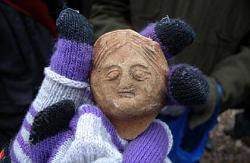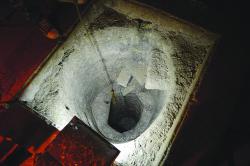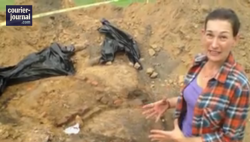INSTITUT SUPERIEUR D'ANTHROPOLOGIE
INSTITUTE OF ANTHROPOLOGY
ONLINE COURSES / COURS A DISTANCE
FALL TERM : OCTOBER 2013
REGISTER NOW
ROYAUME UNI –  Thames - The Thames Discovery Programme (TDP) began providing access to archaeology and leading efforts to record the largest archaeological site in the UK, the Thames foreshore, in October 2008. Since then it has mobilised and trained over 450 volunteers of the Foreshore Recording & Observation Group (the FROGs), monitored over 60 sites at risk on the Thames. In 2010 TDP discovered London’s oldest structure at Vauxhall just metres from the MI6 building. The timber structure, together with a woodworking tool and pottery, was dated to the Mesolithic period and is believed to be over 6,000 years old. Another important discovery came in 2009 at the Charlton foreshore where a group of large timbers were identified as the remains of Victorian 1st rate ship of the line, Duke of Wellington, which at the time of its launch in 1852 was the largest warship of the Royal Navy. The Duke of Wellington served in the Crimean War and for a time even replaced Victory as the Navy’s flagship at Portsmouth. Other sites unearthed through the mudlarking antics of the largely volunteer group include evidence for Bronze Age flint-knapping at Bermondsey, several Anglo-Saxon fish traps, medieval jetties at the Tower of London and Greenwich and the launching slips for Brunel’s SS Great Eastern. But beyond these sites the FROGs have also unearthed a bountiful haul of archaeology that includes everything Roman tiles, pottery fragments and tokens to ivory handles, keys, coins, and even cartwheels. All of these precious foreshaw finds and sites are carefully recorded and many of the finds have boosted the archaeological collection of the Museum of London.
Thames - The Thames Discovery Programme (TDP) began providing access to archaeology and leading efforts to record the largest archaeological site in the UK, the Thames foreshore, in October 2008. Since then it has mobilised and trained over 450 volunteers of the Foreshore Recording & Observation Group (the FROGs), monitored over 60 sites at risk on the Thames. In 2010 TDP discovered London’s oldest structure at Vauxhall just metres from the MI6 building. The timber structure, together with a woodworking tool and pottery, was dated to the Mesolithic period and is believed to be over 6,000 years old. Another important discovery came in 2009 at the Charlton foreshore where a group of large timbers were identified as the remains of Victorian 1st rate ship of the line, Duke of Wellington, which at the time of its launch in 1852 was the largest warship of the Royal Navy. The Duke of Wellington served in the Crimean War and for a time even replaced Victory as the Navy’s flagship at Portsmouth. Other sites unearthed through the mudlarking antics of the largely volunteer group include evidence for Bronze Age flint-knapping at Bermondsey, several Anglo-Saxon fish traps, medieval jetties at the Tower of London and Greenwich and the launching slips for Brunel’s SS Great Eastern. But beyond these sites the FROGs have also unearthed a bountiful haul of archaeology that includes everything Roman tiles, pottery fragments and tokens to ivory handles, keys, coins, and even cartwheels. All of these precious foreshaw finds and sites are carefully recorded and many of the finds have boosted the archaeological collection of the Museum of London.
http://www.culture24.org.uk/history-and-heritage/archaeology/art454241
TURQUIE –  Istanbul - Those tired of the waiting line to enter Sultanahmet’s famous Basilica Cistern will soon have another visiting option following the discovery of a still-active cistern beneath Nuruosmaniye Mosque next to the Grand Bazaar. The 265-year-old cistern was only discovered during renovations to the mosque, according to Foundations Istanbul Provincial Director İbrahim Özekinci. “We removed 420 trucks’ worth of slime from the cistern. Then the magnificent gallery, cistern and water gauge became visible. The Ottomans used a modern system according to contemporary earthquake regulations. This cistern is really a magnificent one, it is very special. All waters from the surrounding gather here. There is also a well under this cistern. After cleaning the mud, we saw that the system was still working,” he said. Restoration work on the cistern is nearing completion. Özekinci said the construction of the Nuruosmaniye Mosque, which is located on one of the seven hills of Istanbul, started in 1748 during the reign of Mahmud I but that the construction was completed in the term of Osman III. “This is why the mosque is called Nuruosmaniye.”He said the mosque depicted the transition in architecture from the classical Ottoman style to baroque with its 174 windows. Özekinci said the cistern was very important in terms of the history of art and that it would be more visible after more restoration work. “The structure includes nearly 19 sections over an area of 2,242 square meters. There are small rooms, galleries and niches. We have one more year to finish it,” Özekinci said.
Istanbul - Those tired of the waiting line to enter Sultanahmet’s famous Basilica Cistern will soon have another visiting option following the discovery of a still-active cistern beneath Nuruosmaniye Mosque next to the Grand Bazaar. The 265-year-old cistern was only discovered during renovations to the mosque, according to Foundations Istanbul Provincial Director İbrahim Özekinci. “We removed 420 trucks’ worth of slime from the cistern. Then the magnificent gallery, cistern and water gauge became visible. The Ottomans used a modern system according to contemporary earthquake regulations. This cistern is really a magnificent one, it is very special. All waters from the surrounding gather here. There is also a well under this cistern. After cleaning the mud, we saw that the system was still working,” he said. Restoration work on the cistern is nearing completion. Özekinci said the construction of the Nuruosmaniye Mosque, which is located on one of the seven hills of Istanbul, started in 1748 during the reign of Mahmud I but that the construction was completed in the term of Osman III. “This is why the mosque is called Nuruosmaniye.”He said the mosque depicted the transition in architecture from the classical Ottoman style to baroque with its 174 windows. Özekinci said the cistern was very important in terms of the history of art and that it would be more visible after more restoration work. “The structure includes nearly 19 sections over an area of 2,242 square meters. There are small rooms, galleries and niches. We have one more year to finish it,” Özekinci said.
http://www.hurriyetdailynews.com/still-active-cistern-beneath-istanbul-mosque.aspx?pageID=238&nid=55541
USA –  Jeffersonville - Nearly two years after finding an old cemetery in Jeffersonville’s Colston Park, archaeologists and field technicians have unearthed more remnants of a 19th century neighborhood beneath the park’s old ballfield. Corn Island Archaeology started the second phase of the study on Monday at the park, which is sandwiched between construction of the new downtown bridge and the Big Four pedestrian/cycling ramp that’s expected to open next month. Using city registries and an insurance map of the neighborhood from the 1800s, archaeologist Mindi Wetzel and about a half-dozen other workers have identified and marked the boundaries of what they believe were houses, a two-story school, a grocery and an African-American church on the west side of Mulberry Street. Clark County historian Jeanne Burke said the Old City Cemetery, also known as the Mulberry Street Cemetery, was used for burials from 1808-1862. Veterans of the Revolutionary War, the War of 1812 and the Mexican War may be among the 300 people who could be buried there. Burke said the cemetery could still include the graves of former U.S. Rep. Thomas Terry Davis, a Kentucky native who later served on the Indiana Territory Supreme Court; the wife of former Jeffersonville Mayor John Daniel Shryer; and Maj. Charles Fuller, a War of 1812 veteran who operated a riverside tavern in Jeffersonville.
Jeffersonville - Nearly two years after finding an old cemetery in Jeffersonville’s Colston Park, archaeologists and field technicians have unearthed more remnants of a 19th century neighborhood beneath the park’s old ballfield. Corn Island Archaeology started the second phase of the study on Monday at the park, which is sandwiched between construction of the new downtown bridge and the Big Four pedestrian/cycling ramp that’s expected to open next month. Using city registries and an insurance map of the neighborhood from the 1800s, archaeologist Mindi Wetzel and about a half-dozen other workers have identified and marked the boundaries of what they believe were houses, a two-story school, a grocery and an African-American church on the west side of Mulberry Street. Clark County historian Jeanne Burke said the Old City Cemetery, also known as the Mulberry Street Cemetery, was used for burials from 1808-1862. Veterans of the Revolutionary War, the War of 1812 and the Mexican War may be among the 300 people who could be buried there. Burke said the cemetery could still include the graves of former U.S. Rep. Thomas Terry Davis, a Kentucky native who later served on the Indiana Territory Supreme Court; the wife of former Jeffersonville Mayor John Daniel Shryer; and Maj. Charles Fuller, a War of 1812 veteran who operated a riverside tavern in Jeffersonville.
VIDEO = http://www.courier-journal.com/article/20131002/NEWS02/310020120/Colston-Park-Jeffersonville-archaeological-dig